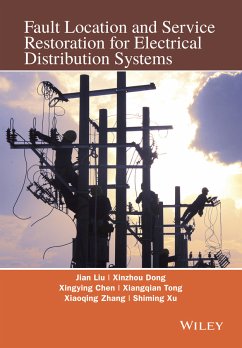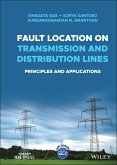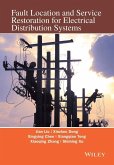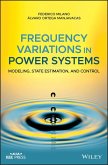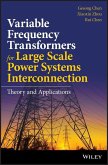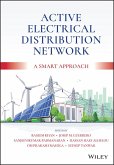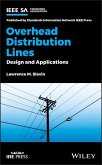Fault Location and Service Restoration for Electrical Distribution Systems (eBook, ePUB)


Alle Infos zum eBook verschenken

Fault Location and Service Restoration for Electrical Distribution Systems (eBook, ePUB)
- Format: ePub
- Merkliste
- Auf die Merkliste
- Bewerten Bewerten
- Teilen
- Produkt teilen
- Produkterinnerung
- Produkterinnerung

Hier können Sie sich einloggen

Bitte loggen Sie sich zunächst in Ihr Kundenkonto ein oder registrieren Sie sich bei bücher.de, um das eBook-Abo tolino select nutzen zu können.
In-depth and systemic examination of distribution automation with specific focus on fault location and service restoration * Focuses on the detailed and systemic examination of fault location and service restoration in distribution grid * Arms the readers with a complete picture of what fault location and service restoration is from both theoretical and practical perspectives * Presents the authors' research on fault location and restoration for distribution systems since 1995 * Introduces the first-hand application experience obtained from over 30 DAS (Distribution Automation System) projects…mehr
- Geräte: eReader
- mit Kopierschutz
- eBook Hilfe
- Größe: 14.3MB
![Fault Location on Transmission and Distribution Lines (eBook, ePUB) Fault Location on Transmission and Distribution Lines (eBook, ePUB)]() Swagata DasFault Location on Transmission and Distribution Lines (eBook, ePUB)90,99 €
Swagata DasFault Location on Transmission and Distribution Lines (eBook, ePUB)90,99 €![Fault Location and Service Restoration for Electrical Distribution Systems (eBook, PDF) Fault Location and Service Restoration for Electrical Distribution Systems (eBook, PDF)]() Jian Guo LiuFault Location and Service Restoration for Electrical Distribution Systems (eBook, PDF)111,99 €
Jian Guo LiuFault Location and Service Restoration for Electrical Distribution Systems (eBook, PDF)111,99 €![Frequency Variations in Power Systems (eBook, ePUB) Frequency Variations in Power Systems (eBook, ePUB)]() Federico MilanoFrequency Variations in Power Systems (eBook, ePUB)119,99 €
Federico MilanoFrequency Variations in Power Systems (eBook, ePUB)119,99 €![Variable Frequency Transformers for Large Scale Power Systems Interconnection (eBook, ePUB) Variable Frequency Transformers for Large Scale Power Systems Interconnection (eBook, ePUB)]() Gesong ChenVariable Frequency Transformers for Large Scale Power Systems Interconnection (eBook, ePUB)117,99 €
Gesong ChenVariable Frequency Transformers for Large Scale Power Systems Interconnection (eBook, ePUB)117,99 €![Active Electrical Distribution Network (eBook, ePUB) Active Electrical Distribution Network (eBook, ePUB)]() Active Electrical Distribution Network (eBook, ePUB)121,99 €
Active Electrical Distribution Network (eBook, ePUB)121,99 €![Overhead Distribution Lines (eBook, ePUB) Overhead Distribution Lines (eBook, ePUB)]() Lawrence M. SlavinOverhead Distribution Lines (eBook, ePUB)86,99 €
Lawrence M. SlavinOverhead Distribution Lines (eBook, ePUB)86,99 €![Electric Power Principles (eBook, ePUB) Electric Power Principles (eBook, ePUB)]() James L. KirtleyElectric Power Principles (eBook, ePUB)86,99 €
James L. KirtleyElectric Power Principles (eBook, ePUB)86,99 €-
-
-
Dieser Download kann aus rechtlichen Gründen nur mit Rechnungsadresse in A, B, BG, CY, CZ, D, DK, EW, E, FIN, F, GR, HR, H, IRL, I, LT, L, LR, M, NL, PL, P, R, S, SLO, SK ausgeliefert werden.
- Produktdetails
- Verlag: Wiley
- Seitenzahl: 256
- Erscheinungstermin: 28. März 2016
- Englisch
- ISBN-13: 9781118950265
- Artikelnr.: 44933065
- Verlag: Wiley
- Seitenzahl: 256
- Erscheinungstermin: 28. März 2016
- Englisch
- ISBN-13: 9781118950265
- Artikelnr.: 44933065
- Herstellerkennzeichnung Die Herstellerinformationen sind derzeit nicht verfügbar.
Preface xi
1 Progresses and Prospects for Fault Processing in Distribution Grids 1
Liu Jian
1.1 Introduction 1
1.2 Progresses in Local Intelligence?-Based Fault Processing 3
1.3 Progresses in Distributed Intelligence?-Based Fault Processing 3
1.4 Progresses in Centralized Intelligence?-Based Fault Processing 4
1.4.1 Fault Location 5
1.4.2 Fault Isolation and Service Restoration 5
1.5 Progresses in Single?]Phase Grounding Fault Processing 6
1.6 Prospects 7
2 Fault Processing Based on Local Intelligence 9
Tong Xiangqian and Liu Jian
2.1 Introduction 9
2.2 Fault Processing Based on Local Intelligence for Distribution Networks
10
2.2.1 Auto?-Reclosure Control 10
2.2.2 Automatic Backup Switching Control of the Reserve Source 11
2.2.3 Voltage Protection 13
2.2.4 Three-Section Over-Current Protection 14
2.2.5 Coordination between Current Protection Relaying and Auto-Reclosure
22
2.2.6 Directional Over?-Current Protection 23
2.2.7 Longitudinal Current Differential Protection 25
2.2.8 The Second Harmonic Braking Criterion in Current Protection 28
2.3 Fault Protection of the Active Distribution Network 32
2.3.1 The Influence of Distributed Generation on Current Protection and the
Adaptive Improvement of Protection 32
2.3.2 Influence of Distributed Generation on Auto?]Reclosure and its
Adaptive Improvements 38
2.3.3 Longitudinal Current Differential Protection of DG Connected
Distribution Networks 40
2.4 Coordination of Multistage Protection in the Distribution Network 41
2.4.1 Time Difference Based Coordination of Multistage Protection in the
Distribution Network 42
2.4.2 The Coordination of Multistage Protection Based on Three?]Section
Over?]Current Protection in the Distribution Network 50
2.4.3 Coordination Modes and Setting Methods of Multistage Protection of
Distribution Networks 58
2.4.4 Example Analysis 68
2.5 Summary 71
3 Fault Processing Based on Distributed Intelligence 73
Liu Jian, Xu Shiming and Chen Xingying
3.1 Introduction 73
3.2 FA based on Recloser and Voltage-Delay Type Sectionalizers 74
3.3 Reclosing with the Fast Over?-Current Protection Mode 78
3.3.1 Basic Principle 78
3.3.2 Improvements 80
3.4 Fast Healing Approach based on Neighbor Communication 82
3.4.1 Basic Principle 82
3.4.2 Improvements 85
3.5 Conclusion and Summary 88
4 Fault Processing Based on Centralized Intelligence 89
Liu Jian and Chen Xingying
4.1 Introduction 89
4.2 Simplified Modeling of Distribution Grids 92
4.2.1 Distribution Network Structure 92
4.2.2 Simplified Load Flow Analysis 98
4.3 Interphase Short Circuit Fault Location 103
4.3.1 Fault Location with Sufficient Information 103
4.3.2 Fault Location with Insufficient Information 111
4.3.3 Fault Location for Distribution Grids with DGs 117
4.4 Fault Isolation and Service Restoration 132
4.4.1 Fault Isolation 133
4.4.2 Service Restoration 135
4.4.3 Modeled Service Restoration 152
4.4.4 Coordination of the Four Types of Service Restoration 159
4.5 Conclusion and Summary 161
5 Single Phase to Ground Fault Processing 163
Dong Xinzhou and Shi Shenxing
5.1 Types of Ground Fault and Protection Strategy 164
5.1.1 The Neutral Grounding Mode and Ground Fault Types 164
5.1.2 The Protection Strategies for Different Types of Ground Faults 167
5.2 Detection of High Resistance Ground Faults in Low Resistance Grounded
Systems 168
5.2.1 High Resistance Ground Faults 168
5.2.2 Zero Sequence Inverse?-Time Overcurrent Protection 169
5.2.3 Grounded Protection based on the Amplitude and Phase of the Third
Harmonic Current 170
5.3 Grounding Protection in the System with Neutral Isolated 174
5.3.1 Characteristics of Single?-Phase-to-Ground Faults in Systems with
Neutral Isolated 174
5.3.2 Single?-Phase-to-Ground Protection in Grids with Neutral Isolated 179
5.4 Grounding Protection in the System with Neutral Grounded Through an Arc
Suppression Coil 180
5.4.1 Characteristics of Single-Phase-to-Ground Faults in Systems with
Neutral Grounded through an Arc Suppression Coil 181
5.4.2 Single?-Phase-to-Ground Protection in Systems with Neutral Grounded
through an Arc Suppression Coil 185
5.5 Single?-Phase-to?-Ground Fault Feeder Selection Technology in a Power
Distribution System with Neutral Non-Effectively Grounded 186
5.5.1 Comparison of Magnitude and Phase based Single?-Phase?-to-Ground
Fault Feeder Selection Methods 187
5.5.2 Characteristics of Single?-Phase-to-Ground Fault Generated Current
Traveling Waves 187
5.5.3 Current Traveling Wave?-based Fault Feeder Selection Method 194
5.6 Prevention of and Protection from Single?]Phase?]to?]Ground Faults in
Power Distribution Systems with Neutral Non?-Effectively Grounded 195
5.6.1 Basic Principle of Single-Phase-to-Ground Fault Prevention 195
5.6.2 Single?-Phase?-to-Ground Fault Prevention Technology 196
5.7 Single?-Phase?-to-Ground Fault Location in Systems with Neutral
Non?]Effectively Grounded 198
5.7.1 Single?-Phase-to-Ground Fault Generated Initial Traveling Waves 198
5.7.2 Single-Phase?-to?-Ground Fault Location Method based on Propagation
Speed of Traveling Waves 202
5.8 Conclusion and Summary 203
6 Practical Aspects of Fault Processing 204
Liu Jian and Zhang Xiaoqing
6.1 Introduction 204
6.2 Coordination of Fault Processing Approaches 205
6.2.1 Fault Processing Performance of Various Methodologies 205
6.3 Planning of Terminal Units 214
6.3.1 Elements Affecting the Reliability of Service 214
6.3.2 Cost?-Benefit Analysis of Action Node Planning 215
6.3.3 Planning the Amount of Terminal Units to Meet the Requirement of
Service Reliability 217
6.4 Verification of the Property of Fault Processing 226
6.4.1 Master Injection Testing Methodology and the Testing Tool 227
6.4.2 Secondary Synchronous Injection Testing Methodology and Testing
Facilities 231
6.4.3 Master and Secondary Synchronous Injection Testing Methodology 232
6.4.4 Direct Short-Circuit Test 234
6.4.5 Comparison of the Four Testing Methodologies 235
6.5 Conclusion and Summary 235
References 238
Index 242
Preface xi
1 Progresses and Prospects for Fault Processing in Distribution Grids 1
Liu Jian
1.1 Introduction 1
1.2 Progresses in Local Intelligence?-Based Fault Processing 3
1.3 Progresses in Distributed Intelligence?-Based Fault Processing 3
1.4 Progresses in Centralized Intelligence?-Based Fault Processing 4
1.4.1 Fault Location 5
1.4.2 Fault Isolation and Service Restoration 5
1.5 Progresses in Single?]Phase Grounding Fault Processing 6
1.6 Prospects 7
2 Fault Processing Based on Local Intelligence 9
Tong Xiangqian and Liu Jian
2.1 Introduction 9
2.2 Fault Processing Based on Local Intelligence for Distribution Networks
10
2.2.1 Auto?-Reclosure Control 10
2.2.2 Automatic Backup Switching Control of the Reserve Source 11
2.2.3 Voltage Protection 13
2.2.4 Three-Section Over-Current Protection 14
2.2.5 Coordination between Current Protection Relaying and Auto-Reclosure
22
2.2.6 Directional Over?-Current Protection 23
2.2.7 Longitudinal Current Differential Protection 25
2.2.8 The Second Harmonic Braking Criterion in Current Protection 28
2.3 Fault Protection of the Active Distribution Network 32
2.3.1 The Influence of Distributed Generation on Current Protection and the
Adaptive Improvement of Protection 32
2.3.2 Influence of Distributed Generation on Auto?]Reclosure and its
Adaptive Improvements 38
2.3.3 Longitudinal Current Differential Protection of DG Connected
Distribution Networks 40
2.4 Coordination of Multistage Protection in the Distribution Network 41
2.4.1 Time Difference Based Coordination of Multistage Protection in the
Distribution Network 42
2.4.2 The Coordination of Multistage Protection Based on Three?]Section
Over?]Current Protection in the Distribution Network 50
2.4.3 Coordination Modes and Setting Methods of Multistage Protection of
Distribution Networks 58
2.4.4 Example Analysis 68
2.5 Summary 71
3 Fault Processing Based on Distributed Intelligence 73
Liu Jian, Xu Shiming and Chen Xingying
3.1 Introduction 73
3.2 FA based on Recloser and Voltage-Delay Type Sectionalizers 74
3.3 Reclosing with the Fast Over?-Current Protection Mode 78
3.3.1 Basic Principle 78
3.3.2 Improvements 80
3.4 Fast Healing Approach based on Neighbor Communication 82
3.4.1 Basic Principle 82
3.4.2 Improvements 85
3.5 Conclusion and Summary 88
4 Fault Processing Based on Centralized Intelligence 89
Liu Jian and Chen Xingying
4.1 Introduction 89
4.2 Simplified Modeling of Distribution Grids 92
4.2.1 Distribution Network Structure 92
4.2.2 Simplified Load Flow Analysis 98
4.3 Interphase Short Circuit Fault Location 103
4.3.1 Fault Location with Sufficient Information 103
4.3.2 Fault Location with Insufficient Information 111
4.3.3 Fault Location for Distribution Grids with DGs 117
4.4 Fault Isolation and Service Restoration 132
4.4.1 Fault Isolation 133
4.4.2 Service Restoration 135
4.4.3 Modeled Service Restoration 152
4.4.4 Coordination of the Four Types of Service Restoration 159
4.5 Conclusion and Summary 161
5 Single Phase to Ground Fault Processing 163
Dong Xinzhou and Shi Shenxing
5.1 Types of Ground Fault and Protection Strategy 164
5.1.1 The Neutral Grounding Mode and Ground Fault Types 164
5.1.2 The Protection Strategies for Different Types of Ground Faults 167
5.2 Detection of High Resistance Ground Faults in Low Resistance Grounded
Systems 168
5.2.1 High Resistance Ground Faults 168
5.2.2 Zero Sequence Inverse?-Time Overcurrent Protection 169
5.2.3 Grounded Protection based on the Amplitude and Phase of the Third
Harmonic Current 170
5.3 Grounding Protection in the System with Neutral Isolated 174
5.3.1 Characteristics of Single?-Phase-to-Ground Faults in Systems with
Neutral Isolated 174
5.3.2 Single?-Phase-to-Ground Protection in Grids with Neutral Isolated 179
5.4 Grounding Protection in the System with Neutral Grounded Through an Arc
Suppression Coil 180
5.4.1 Characteristics of Single-Phase-to-Ground Faults in Systems with
Neutral Grounded through an Arc Suppression Coil 181
5.4.2 Single?-Phase-to-Ground Protection in Systems with Neutral Grounded
through an Arc Suppression Coil 185
5.5 Single?-Phase-to?-Ground Fault Feeder Selection Technology in a Power
Distribution System with Neutral Non-Effectively Grounded 186
5.5.1 Comparison of Magnitude and Phase based Single?-Phase?-to-Ground
Fault Feeder Selection Methods 187
5.5.2 Characteristics of Single?-Phase-to-Ground Fault Generated Current
Traveling Waves 187
5.5.3 Current Traveling Wave?-based Fault Feeder Selection Method 194
5.6 Prevention of and Protection from Single?]Phase?]to?]Ground Faults in
Power Distribution Systems with Neutral Non?-Effectively Grounded 195
5.6.1 Basic Principle of Single-Phase-to-Ground Fault Prevention 195
5.6.2 Single?-Phase?-to-Ground Fault Prevention Technology 196
5.7 Single?-Phase?-to-Ground Fault Location in Systems with Neutral
Non?]Effectively Grounded 198
5.7.1 Single?-Phase-to-Ground Fault Generated Initial Traveling Waves 198
5.7.2 Single-Phase?-to?-Ground Fault Location Method based on Propagation
Speed of Traveling Waves 202
5.8 Conclusion and Summary 203
6 Practical Aspects of Fault Processing 204
Liu Jian and Zhang Xiaoqing
6.1 Introduction 204
6.2 Coordination of Fault Processing Approaches 205
6.2.1 Fault Processing Performance of Various Methodologies 205
6.3 Planning of Terminal Units 214
6.3.1 Elements Affecting the Reliability of Service 214
6.3.2 Cost?-Benefit Analysis of Action Node Planning 215
6.3.3 Planning the Amount of Terminal Units to Meet the Requirement of
Service Reliability 217
6.4 Verification of the Property of Fault Processing 226
6.4.1 Master Injection Testing Methodology and the Testing Tool 227
6.4.2 Secondary Synchronous Injection Testing Methodology and Testing
Facilities 231
6.4.3 Master and Secondary Synchronous Injection Testing Methodology 232
6.4.4 Direct Short-Circuit Test 234
6.4.5 Comparison of the Four Testing Methodologies 235
6.5 Conclusion and Summary 235
References 238
Index 242
